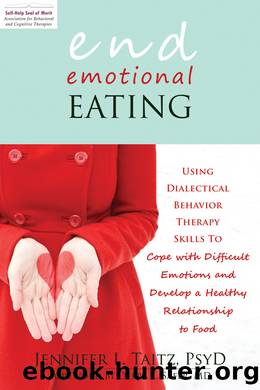End Emotional Eating: Using Dialectical Behavior Therapy Skills to Cope With Difficult Emotions and Develop a Healthy Relationship to Food by Jennifer Taitz

Author:Jennifer Taitz
Language: eng
Format: mobi
ISBN: 1608821234
Publisher: New Harbinger Publications
Published: 2012-07-02T00:00:00+00:00
Half-smiling is a way to act opposite in difficult situations. You may experiment with bringing to mind a person you dislike while half-smiling. You may notice differences in your feelings as you sit with the person, before you or in your mind, while assuming an expression of acceptance.
When you suppress an emotion, you are restraining the feeling and not practicing acceptance. When you change an emotional expression, you are accepting your emotion, relaxing your body, and modifying your experience and expression of the emotion. Thereâs a difference between the two strategies, and it has to do with acceptance. Acting opposite is not faking; rather itâs noticing urges to act in a certain way, then deliberately choosing to change your thoughts and behavior, all with a quality of acceptance. Half-smiling is not insincere; itâs noticing when your face conveys nonacceptance and changing your expression to a more accepting one. Imagine when someone asks you to smile for a photograph. Iâd bet your face feels quite tense and uncomfortable, especially if you hold it for a while. Try that for a moment if you will: adopt a big, toothy, inauthentic camera smile. When you release the face, take a few moments to let go of any tension you may experience in your face. Then, deliberately release any tension in your forehead, bring your attention to this moment, and ever so slightly raise the corners of your mouth. Notice the difference?
Changing your emotional response is a commitment to engage in a behavior that relates to what matters. Avoiding or suppressing is committing to trying to feel less. The distinction is subtle. For example, if you feel anxious at a party, you may accept your anxiety and choose to act opposite by lifting your head up, making eye contact, introducing yourself, and half-smiling, even if a thought arises that makes you anxious and you donât feel perfectly comfortable. Suppressing is going to the party and trying to look cool and calm. Acting opposite may actually increase your anxiety initially, though over time, opposite action will change the way you feel.
Download
This site does not store any files on its server. We only index and link to content provided by other sites. Please contact the content providers to delete copyright contents if any and email us, we'll remove relevant links or contents immediately.
Spare by Prince Harry The Duke of Sussex(5072)
Machine Learning at Scale with H2O by Gregory Keys | David Whiting(4172)
Fairy Tale by Stephen King(3216)
Will by Will Smith(2790)
Hooked: A Dark, Contemporary Romance (Never After Series) by Emily McIntire(2496)
The Bullet Journal Method by Ryder Carroll(2484)
Rationality by Steven Pinker(2290)
Can't Hurt Me: Master Your Mind and Defy the Odds - Clean Edition by David Goggins(2225)
It Starts With Us (It Ends with Us #2) by Colleen Hoover(2194)
Friends, Lovers, and the Big Terrible Thing by Matthew Perry(2116)
The Becoming by Nora Roberts(2085)
Love on the Brain by Ali Hazelwood(1962)
The Strength In Our Scars by Bianca Sparacino(1776)
HBR's 10 Must Reads 2022 by Harvard Business Review(1776)
A Short History of War by Jeremy Black(1758)
Leviathan Falls (The Expanse Book 9) by James S. A. Corey(1646)
515945210 by Unknown(1598)
A Game of Thrones (The Illustrated Edition) by George R. R. Martin(1587)
Bewilderment by Richard Powers(1535)
